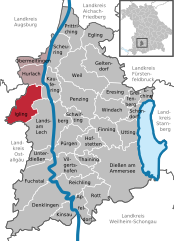Igling | |
|---|---|
 Castle in Holzhausen bei Buchloe | |
Location of Igling within Landsberg am Lech district  | |
| Coordinates: 48°04′N10°48′E / 48.067°N 10.800°E | |
| Country | Germany |
| State | Bavaria |
| Admin. region | Oberbayern |
| District | Landsberg am Lech |
| Municipal assoc. | Igling |
| Subdivisions | 3 Ortsteile |
| Government | |
| • Mayor (2020–26) | Günter Först [1] (FW) |
| Area | |
• Total | 26.37 km2 (10.18 sq mi) |
| Highest elevation | 611 m (2,005 ft) |
| Lowest elevation | 593 m (1,946 ft) |
| Population (2023-12-31) [2] | |
• Total | 2,583 |
| • Density | 98/km2 (250/sq mi) |
| Time zone | UTC+01:00 (CET) |
| • Summer (DST) | UTC+02:00 (CEST) |
| Postal codes | 86859 |
| Dialling codes | 08248 |
| Vehicle registration | LL |
| Website | www.igling.de |
Igling is a municipality in the district of Landsberg in Bavaria in Germany.



